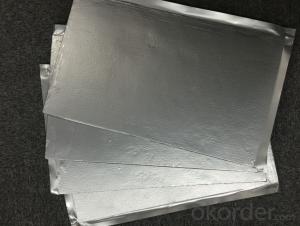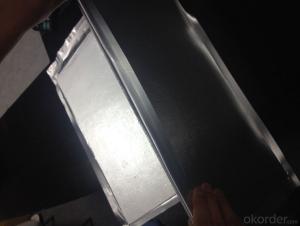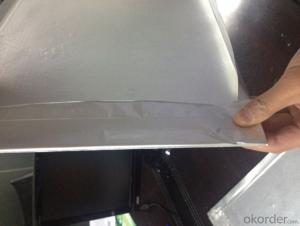Microporous Insulation Board Classification Temp. 1100℃
- Loading Port:
- Qingdao
- Payment Terms:
- TT or LC
- Min Order Qty:
- 100 kg
- Supply Capability:
- 2000000 kg/month
OKorder Service Pledge
OKorder Financial Service
You Might Also Like
General Information of Microporous Insulation Board
CMAX Microporous Insulation Board is specially designed for steel industry & metallurgy with very good thermal and mechanical properties. The formulation is an opacified blend of filament reinforced pyrogenic silica. The coverings is water repellent to assure the stability of the microporous board when moisture may occur due to castables, mortar etc.
Features of Microporous Insulation Board
Extremely low thermal conductivity
High compressive strength
High thermal stability
Environment protection
Easy to handle
No harmful inhalable fibers
Resist most chemical attacks
Free of organic binders
Non combustible
Working & Processing of Microporous Insulation Board
CMAX Microporous Insulation Board can be shaped easily with a simple cutter and taped off with aluminum tape. The microporous insulation board can be fixed in place with the same adhesives that are used for refractory lining.
Image of Microporous Insulation Board



Technical Data of Microporous Insulation Board

Application of Microporous Insulation Board
Ladle
Torpedo Ladle
EAF
Degassers
Cement Rotary Kiln
Ceramic Firing Kiln
Aluminum Melting and Holding Furnace and so on
Why Choose Us
l We are a government owned company with ISO certificate.
l We are listed in Global Fortune 500 with D & B report.
l We have more than 11 refractory production facilities and bases across China. We have a wide products range, such as ceramic fiber products (ceramic fiber blanket, module, board, paper, bulk), ceramic fiber textile (ceramic fiber rope, cloth, tape, yarn) etc, refractory brick (fireclay brick, high alumina brick, silica brick, magnesia brick etc), monolithic refractory materials, insulating fire brick, calcium silicate board, mica sheet, steel fiber. You can find various products here, and we can combine the light weight ceramic fiber products with the heavy weight refractory brick in one container delivery, then save the sea freight for you.
l We have strict materials selecting system and quality control system. We have the ability to take responsibility for your orders and product quality.
FAQ
Q1: How do you control the products quality?
A1: With strict quality control system throughout the materials selection and production process, our refractory and ceramic fiber products quality is effectively controlled to meet customer requirements.
From the raw materials selecting, our quality control begin. The quality certificates of raw materials are required and each batch will be tested before using. During production, the quality control are conducted by workers and then each piece will be sorted and examined by quality supervis
Q2: What`s the lead time for my order?
A2: It depends on customers’ requirements and our production schedule. And usually we need 30-60 days for refractory bricks,10-25 days for unshaped refractory materials and 10-20 days for ceramic fiber blankets.
Q3: Can you offer Door-to-Door delivery?
A3: Yes, but only for some countries such us U.S., UAE, Saudi Arabia, Iran, and Russia, etc.
Q4: What is the minimum quantity?
A4: There is no minimum order quantity. Depending on the item and processing, there may be a minimum production required, however we can offer a quotation based only on the quantity you need.
Q5: Can you give me a brief introduction of the application of your products?
A5: CNBM (China National Building Material) core refractory business comprises the production, sale and installation of high-grade refractory products, the development and implementation of customized system solutions as well as rendering outstanding services for the key industries in Glass, Iron& Steel, Petrochemical, Cement, Ceramic and Nonferrous Metals.
- Q: What kind of insulation material can withstand 350-600 degrees of high temperature?
- Suggest that you refer to the above two data to choose from, select only from the temperature, you can use
- Q: Which is better, asbestos free calcium silicate and aluminium silicate refractory fiber?
- The two are thermal insulation materials. Calcium silicate board strength, cheap, but the use of temperature is not high, the highest 1000 degrees.
- Q: What is the difference between calcium silicate board and cement fiber board?
- How to distinguish fiber cement, pressure plate and calcium silicate board?1, calculate density: calcium silicate board density is much lower than the fiber cement pressure plate, through the weight of the plate can calculate its approximate density.2, look at the color: Although there are manufacturers in order to pretend to be fiber cement pressure plate and deliberately add carbon black and so on, the board made dark, but not natural cement color.3, ask whether there are super thin plate and super thick plate, if not or can not do, it means that he is selling calcium silicate board or ordinary fiber cement, non pressure plate.4, if you go to the factory, you can visit its workshop, if there is steam pressure (commonly known as bullets), it is certainly calcium silicate board manufacturers, if there is no press, it is a common cement plant.
- Q: Asbestos free calcium silicate board there is a crack in the kettle, what is the reason?
- A slab of calcium silicate board production equipment to the emergence of the phenomenon of billet stick (stick billet refers to the calcium silicate board blank attached to the molding cylinder, in shaping cylinder knife when tearing into the surface depression caused by repeatedly feeding back, yield, effect in this case a two quality, three lead to rising production costs)There are two reasons for the phenomenon of sticking: first, the slurry temperature is low, viscosity is big; two, the material is not dehydrated enough, and the moisture content is high.The solution is: 1, improve the slurry temperature, slurry concentration decreased, but the slurry temperature should not exceed 45 DEG C; 2, in the premise of not causing product layer under the vacuum degree increasing, strengthen dehydration, reduce water blanks.
- Q: Cement is not silicate products
- There are different kinds of cement: silicate series, aluminate series, sulphoaluminate series, sulfur ferrite system, etc.
- Q: Why is calcium silicate board unsuitable for use in home improvement?
- Calcium silicate board is calcium silicate gypsum board, mainly with gypsum. At present, mainly 600*600MM, mostly used as large space, clear keel ceiling. But the family area is small, makes the Ming keel, the cost is high, also does not look well. This is why most families use a ceiling ceiling panels (gypsum board, calcium silicate board) ceiling.
- Q: What are the new energy-saving building materials? What's new?
- As far as its varieties are concerned, the new wall materials mainly include bricks, blocks and slabs, such as clay hollow bricks, waste clay bricks, non clay bricks, building blocks, aerated concrete, light plates and composite boards.
- Q: What's the use of white portland cement?
- The typical feature of white cement is high whiteness, with bright color, generally used for a variety of architectural decoration materials, painting, sculpture, a typical floor, terrazzo, white cement can be used to produce white and colored concrete, is the largest cement production decoration.
- Q: What's the difference between white cement and ordinary cement?
- The main chemical composition of Portland cement clinker is calcium oxide, silica, alumina and iron oxide. Calcium oxide mainly derived from calcareous raw materials, such as limestone, chalk, marl; alumina and silica from aluminum silicate containing substances, such as clay, blast furnace slag and fly ash; iron oxide is used in sulfuric acid production of sulfur iron slag. For the content of calcium oxide production of Portland cement lime materials in 52%; silicon oxide content of clay in raw materials up to about 57%, the alumina content is less than 20%. In order to reduce the calcination temperature and to produce part of the melt during calcination, a small amount of iron oxide is often added. Of raw materials but also control the content of alkali and Magnesium Oxide, Magnesium Oxide is content in the cement clinker should be less than 5%, total alkalinity (Na2O+K2O) for general cement should be less than 1.2% of low alkali cement should be less than 0.6%.
- Q: What is dew point of thermal insulation material?
- Thermal insulation materials are generally used to guide heat coefficient less than or equal to 0.2 of the material. Thermal insulation material development is very fast, and in industry and building the use of good insulation technology and materials, often can get twice the result with half the effort. Each ton of mineral cotton insulation used in the building saves one ton of oil a year.
Send your message to us
Microporous Insulation Board Classification Temp. 1100℃
- Loading Port:
- Qingdao
- Payment Terms:
- TT or LC
- Min Order Qty:
- 100 kg
- Supply Capability:
- 2000000 kg/month
OKorder Service Pledge
OKorder Financial Service
Similar products
Hot products
Hot Searches
Related keywords




























